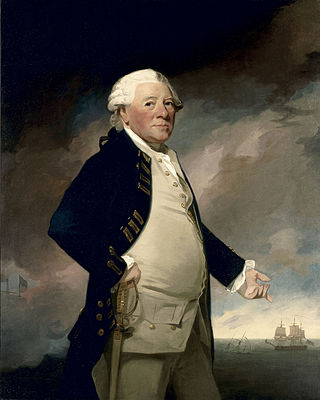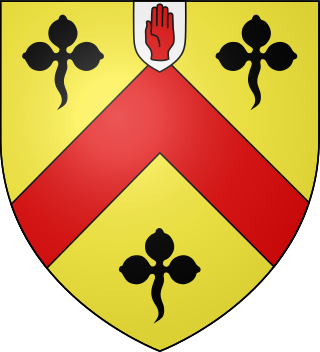
Viscount Gage, of Castle Island in the County of Kerry of the Kingdom of Ireland, is a title in the Peerage of Ireland. It was created in 1720 for Thomas Gage, along with the subsidiary title of Baron Gage, of Castlebar in the County of Mayo, also in the Peerage of Ireland. In 1744 he also succeeded his cousin as eighth Baronet, of Firle Place. The titles remain united. The Gage family descends from John Gage, who was created a baronet, of Firle Place in the County of Sussex, in the Baronetage of England on 26 March 1622. His great-grandson, the seventh Baronet, represented Seaford in Parliament. He was succeeded by his first cousin, Thomas Gage, 1st Viscount Gage, the eighth Baronet. He sat as a Member of Parliament for Minehead and Tewkesbury and also served as Governor of Barbados. In 1720, 24 years before succeeding in the baronetcy, he was raised to the Peerage of Ireland as Baron Gage and Viscount Gage. His second son was the military commander the Hon. Thomas Gage.

There have been three baronetcies created for persons with the surname Booth, one in the Baronetage of England and two in the Baronetage of the United Kingdom. The 1916 creation remains extant, the 1835 creation became extinct in 1896 and the 1611 baronetcy has been dormant since 1797. The senior line of the first creation was elevated to the peerage as Baron Delamer and Earl of Warrington.

The Bunbury Baronetcy, of Bunbury, Oxon and Stanney Hall in the County of Chester, is a title in the Baronetage of England. It was created on 29 June 1681 for Thomas Bunbury, Sheriff of Cheshire from 1673 to 1674 and the member of an ancient Cheshire family. His grandson, Henry, the third Baronet, and great-grandson, the fourth Baronet, both sat as Members of Parliament for Chester. The latter died unmarried at an early age and was succeeded by his younger brother, the fifth Baronet. He was a clergyman. On his death in 1764 the title passed to his eldest son, the sixth Baronet. He represented Suffolk in the House of Commons for over forty years but is best remembered for his marriage to Lady Sarah Lennox. He died childless in 1821 and was succeeded by his nephew, the seventh Baronet. He was the son of Henry Bunbury, younger son of the fifth Baronet. The seventh Baronet was a distinguished soldier and politician. His eldest son, the eighth Baronet, was High Sheriff of Suffolk in 1868, and Fellow of the Royal Society. He died childless in 1886 and was succeeded by his younger brother, the ninth Baronet. He was Liberal Member of Parliament for Bury St Edmunds. He died unmarried in 1895 and was succeeded by his nephew, the tenth Baronet. He was the son of Colonel Henry William St Pierre Bunbury, third son of the seventh Baronet. He served as High Sheriff of Suffolk in 1908 and was a Deputy Lieutenant of the county. On his death in 1930 the title passed to his son, the eleventh Baronet. He was High Sheriff of Suffolk in 1936 and was a Deputy Lieutenant of the county. His son, the twelfth Baronet, was High Sheriff of Suffolk in 1972. As of 2014 the title was held by the latter's second but eldest surviving son, the thirteenth Baronet, who succeeded in 1985.
The Adair Baronetcy, of Flixton Hall in the County of Suffolk, was a title in the Baronetage of the United Kingdom. It was created on 2 August 1838 for Robert Adair. He was succeeded by his eldest son, the second Baronet. He sat as Member of Parliament for Cambridge. In 1873 he was created Baron Waveney, of South Elmham in the County of Suffolk, in the Peerage of the United Kingdom. The barony became extinct on his death in 1886 while he was succeeded in the baronetcy by his younger brother, Hugh Adair, the third Baronet. The latter had earlier represented Ipswich in Parliament. Two of his sons, the fourth and fifth Baronets, both succeeded in the title. The fifth Baronet's son, the sixth Baronet, was a major general in the British Army. The title became extinct on the latter's death in 1988.

There have been seven baronetcies created for persons with the surname Parker, three in the Baronetage of England, two in the Baronetage of Great Britain and two in the Baronetage of the United Kingdom. Two of the creations are extant as of 2008. Though none of the different families of baronets were related, several supplied a number of flag officers to the Royal Navy.
There have been three baronetcies created for members of the Gore family, all in the Baronetage of Ireland. All three titles are extant. The family also holds two earldoms and a barony.
There have been six baronetcies created for persons with the surname Brooke, one in the Baronetage of England, one in the Baronetage of Ireland and four in the Baronetage of the United Kingdom. As of 2015 four of the creations are extant, though one has been subsumed into a peerage.

There have been twenty one baronetcies created for persons with the surname Williams, eight in the Baronetage of England, three in the Baronetage of Great Britain and ten in the Baronetage of the United Kingdom. Only six of the creations are extant as of 2017.
There have been two baronetcies created for persons with the surname Prescott, one in the Baronetage of Great Britain and one in the Baronetage of the United Kingdom.

There have been four baronetcies created for members of the Welsh Philipps family, one in the Baronetage of England and three in the Baronetage of the United Kingdom.
The Houstoun, later Houstoun-Boswall Baronetcy, is a title in the Baronetage of the United Kingdom.

The Couper Baronetcy is a title in the Baronetage of the United Kingdom. It was created on 23 June 1841 for George Couper. He was a colonel in the Army and fought in the Peninsular War, served as Military Secretary to the Governor Generals of Canada, Sir James Kempt and Lord Durham, and was Comptroller of the Household and Equerry to Her Royal Highness the Duchess of Kent. The second Baronet was an administrator in India and served as Governor of the North-West Provinces between 1877 and 1882. Another member of the family to gain distinction was James Kempt Couper, second son of the first Baronet. He was a general in the Army.
There have been three baronetcies created for persons with the surname Dryden, one in the Baronetage of England and two in the Baronetage of Great Britain. Two of the creations are extant and are joined under a single holder since 1874.
The Baker, later Sherston-Baker Baronetcy, of Dunstable House in Richmond in the County of Surrey, is a title in the Baronetage of Great Britain. It was created on 14 May 1796 for Robert Baker, in honour of him raising and maintaining a cavalry regiment of 500 men styled "The Richmond Rangers" for King George III. He was succeeded by his son, the second Baronet. He was a vice-admiral in the Royal Navy. The fourth Baronet was a Recorder of Helston and of Barnstaple and Bideford and a County Court judge. The fifth Baronet assumed by deed poll the additional surname of Sherston in 1923. The Baker family was settled in the Westcountry several centuries before the creation of the baronetcy. A version of the arms used by the Baker baronets is displayed on the mural monument in Dunchideock Church in Devon of Aaron Baker (1620–1683) of Bowhay in the parish of Exminster, Devon, first President of the Madras Presidency.

The Milman Baronetcy, of Levaton-in-Woodland in the County of Devon, is a title in the Baronetage of Great Britain. It was created on 28 November 1800 for Francis Milman, Physician-in-Ordinary to King George III and President of the Royal College of Physicians. The seventh Baronet was a brigadier-general in the British Army.
There have been four baronetcies created for members of the Thorold family of Lincolnshire, two in the Baronetage of England and two in the Baronetage of Great Britain. As of 2014 one creation is extant.

Llwynywermod, also known as Llwynywormwood, is an estate owned by the Duchy of Cornwall, just outside the Brecon Beacons National Park in Carmarthenshire, Wales. The 192-acre (0.78 km2) estate is near the village of Myddfai, Llandovery, Carmarthenshire.
The Borrowes Baronetcy of Grangemellon in the County of Kildare, was a title in the Baronetage of Ireland. It was created on 14 February 1646 for Erasmus Borrowes, High Sheriff of Kildare in 1641. Erasmus was the son of Henry Borrowes of Gilltown, who emigrated from Devon to Ireland in the reign of Elizabeth I. Through his mother Jane, Erasmus was the grandson of the distinguished soldier and politician Sir Arthur Savage.
There have been two baronetcies created for persons with the surname Pickering, one in the Baronetage of Nova Scotia and one in the Baronetage of England. Both creations are extinct.

The Abdy Baronetcy, of Albyns, in the County of Essex, was created in the Baronetage of the United Kingdom on 22 December 1849 for Thomas Neville Abdy who sat for Lyme Regis in the British House of Commons. It was a second creation for the seat: see Abdy baronets of Albyns (1660).











